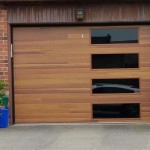Transform Your Garage Door With Faux Wood Grain Paint Roller
A garage door, often a significant feature in a home's facade, can significantly impact curb appeal. Over time, the original paint may fade, chip, or simply become outdated. Replacing a garage door can be a costly endeavor. A cost-effective alternative is to transform the appearance of a plain metal or composite garage door into a realistic wood grain finish using a faux wood grain paint roller. This technique offers a way to dramatically enhance the look of a home without the expense of a full replacement. This article details the process, required materials, and essential considerations for achieving a professional-looking faux wood grain finish on a garage door.
The process involves applying a base coat of paint, followed by using a specialized wood grain roller to create the desired wood texture. The key to success lies in careful preparation, proper application techniques, and the selection of appropriate materials. This method allows homeowners to customize the finish, choosing from various wood grain patterns and stain colors to complement their homes' architectural style.
Preparation is Paramount
Proper preparation is crucial for achieving a durable and aesthetically pleasing faux wood grain finish. Neglecting this step can lead to adhesion problems, uneven textures, and ultimately, a less-than-desirable outcome. The preparation process involves cleaning the garage door, repairing any damage, and priming the surface to ensure proper paint adhesion.
The first step is thoroughly cleaning the garage door. Use a pressure washer or a scrub brush and a solution of warm water and mild detergent to remove dirt, grime, mildew, and any loose paint. Rinse the door thoroughly with clean water and allow it to dry completely. This ensures that the primer and paint will adhere properly to the surface.
Inspect the garage door for any damage, such as dents, scratches, or rust. Minor dents can be filled with automotive body filler. Sand the filled areas smooth with fine-grit sandpaper. For rusted areas, use a wire brush or sandpaper to remove loose rust. Apply a rust-inhibiting primer to prevent further corrosion.
Priming the garage door is an essential step, especially for metal surfaces. Primer creates a uniform surface and enhances paint adhesion. Choose a primer specifically designed for the material of the garage door (e.g., metal, wood composite). Apply the primer according to the manufacturer's instructions, typically using a brush, roller, or sprayer. Allow the primer to dry completely before proceeding to the next step. Two coats of primer may be necessary for optimal adhesion and coverage.
Masking off surrounding areas with painter's tape is essential to protect surfaces from unwanted paint splatters. Apply tape along the edges of the garage door, including the trim, windows, and surrounding walls. Use drop cloths or plastic sheeting to cover the ground and any nearby objects. This will minimize cleanup time and ensure a professional-looking finish.
Applying the Base Coat and Wood Grain
The base coat provides the foundation for the faux wood grain finish. Selecting the appropriate base coat color is crucial for achieving the desired wood tone. The base coat should be a color that closely resembles the undertones of the wood species being replicated. For example, a warm brown base coat is suitable for replicating oak or walnut, while a lighter tan base coat is appropriate for replicating pine or maple.
Apply the base coat using a high-quality brush, roller, or sprayer. Ensure even coverage and avoid drips or runs. Two thin coats are generally better than one thick coat, as this promotes better adhesion and a smoother finish. Allow each coat to dry completely according to the paint manufacturer's instructions. Lightly sand the base coat with fine-grit sandpaper to remove any imperfections and create a smooth surface for the wood grain application.
The wood grain effect is achieved using a specialized faux wood grain paint roller. These rollers are designed with a patterned surface that imprints a wood grain texture onto the wet paint. There are various types of wood grain rollers available, each creating a different grain pattern. Experimenting with different rollers on a test surface is recommended to determine the desired effect. It is important to choose a wood grain roller that corresponds to the targeted wood species.
Apply a glaze or topcoat in a color that contrasts with the base coat. This glaze will be used to create the wood grain effect. The color of the glaze should complement the base coat and resemble the natural color variations found in wood. For example, a darker brown glaze can be used over a lighter tan base coat to create a realistic wood grain effect. Apply the glaze in a thin, even layer using a brush or roller. Work in small sections to prevent the glaze from drying before the wood grain roller is applied.
While the glaze is still wet, use the wood grain roller to create the desired texture. Roll the roller over the wet glaze in a smooth, consistent motion. Apply even pressure to ensure a uniform grain pattern. Experiment with different rolling techniques, such as overlapping strokes or varying the pressure, to create a more natural-looking wood grain effect. Wipe the wood grain roller clean periodically with a damp cloth to remove excess glaze and maintain a clear grain pattern. Repeating the rolling process will enhance the wood grain pattern. Practice on a test surface before applying the technique to the garage door.
Achieving a Realistic and Durable Finish
Achieving a realistic wood grain finish requires careful attention to detail and the use of appropriate techniques. The direction of the wood grain should be consistent and follow the natural lines of the garage door panels. For example, on a panel garage door, the wood grain should generally run horizontally. Avoid creating unrealistic or unnatural grain patterns. Observe real wood grain patterns to replicate them accurately.
Blending and feathering the edges of the wood grain pattern is essential for creating a seamless and natural-looking finish. Use a dry brush to soften the edges of the grain pattern and blend it into the surrounding areas. This will eliminate harsh lines and create a more subtle transition between the base coat and the wood grain. Lightly sand the wood grain pattern with fine-grit sandpaper to further soften the texture and create a smoother finish.
Adding subtle variations in color and tone can enhance the realism of the faux wood grain finish. Use a brush or sponge to apply small amounts of different colored glazes or stains to the wood grain pattern. These variations can mimic the natural color variations found in wood, such as knots, sapwood, and heartwood. Avoid overdoing the color variations, as too much contrast can look artificial. Use a light touch and blend the colors carefully to create a natural and subtle effect.
Protecting the faux wood grain finish with a clear topcoat is essential for ensuring its durability and longevity. A clear topcoat will protect the paint from the elements, such as sun, rain, and snow. It will also make the finish easier to clean and maintain. Choose a topcoat that is specifically designed for exterior use and is compatible with the type of paint used for the base coat and wood grain. Apply the topcoat according to the manufacturer's instructions, typically using a brush, roller, or sprayer. Multiple coats of topcoat may be necessary for optimal protection. Ensure that the garage door is completely dry before applying the topcoat.
Maintaining the faux wood grain finish is crucial for preserving its appearance and extending its lifespan. Regularly clean the garage door with a mild detergent and water to remove dirt and grime. Avoid using harsh chemicals or abrasive cleaners, as these can damage the paint finish. Inspect the garage door periodically for any signs of damage, such as chips, scratches, or fading. Touch up any damaged areas with matching paint or glaze. Reapply the clear topcoat every few years to maintain its protective properties. With proper care and maintenance, a faux wood grain finish can provide years of beauty and enhance the curb appeal of a home.
By following these steps and paying close attention to detail, homeowners can successfully transform their garage doors into stunning faux wood grain masterpieces. The result is an enhanced home aesthetic without incurring the significant expense of replacing the entire garage door.

Faux Wood Garage Door Tutorial Prodigal Pieces

8 Diy Tips For Painting Garage Door To Look Like Wood Fun Home Building

The Step By Guide To Painting Your Garage Door Look Like Stained Wood In My Own Style

How To Paint Your Garage Door Look Like Wood Giani Inc

Faux Wood Garage Door Tutorial Prodigal Pieces

How To Paint Your Garage Door A Faux Wood Finish Today S Homeowner

Faux Wood Garage Doors Dam S Arts

Old Metal Garage Door Transformation Faux Wood Finish Detailed Diy Instructions

Faux Wood Garage Door Tutorial Prodigal Pieces

How To Paint Your Garage Door A Faux Wood Finish Today S Homeowner
Related Posts








